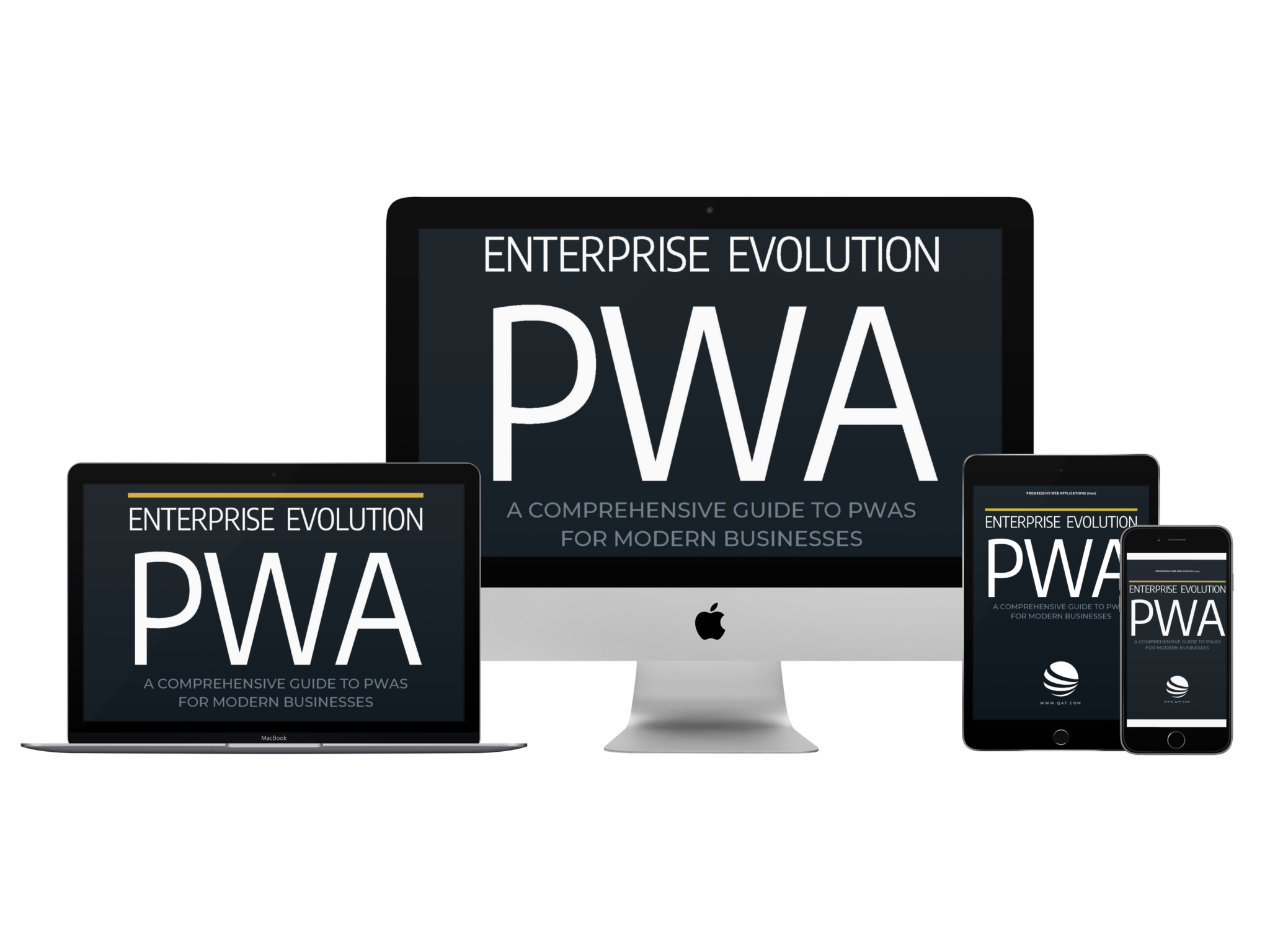Why Progressive Web Applications for Your Enterprise?

Why Progressive Web Applications for Your Enterprise?

Explore the advantages and transformative benefits of adopting PWAs in the corporate landscape. From enhanced user experience to streamlined development, this article delves into the compelling reasons why PWAs are becoming a game-changer for enterprises seeking efficient, scalable, and engaging digital solutions.
Why Progressive Web Applications (PWA) for Your Enterprise?
“Progressive web application” is a term created by Google to signify any web-based software delivered via a website yet works similarly to a native mobile application. Progressive Web Applications (PWAs) were born from the need to provide a mobile experience that encompasses interactivity, multiple-task performance, and streamlined code maintainability. PWAs make revisiting their enterprise mobile strategy a smart business decision for many enterprises.
Traditional websites provide users with one-way communication, serving their purpose as information deliverers for various applications. Websites, however, typically lack user interaction and limit usability for mobile access. On the other hand, native mobile apps enable extensive user interactions for a specific set of tasks. Mobile apps also require a particular operating system, like iOS or Android, meaning if you wanted users from both platforms to access your mobile app, you’d have to create an app for each. PWAs deliver the best of both while eliminating or minimizing their weaknesses.
Below are several reasons enterprise organizations are moving to progressive web applications and why it might be a smart move for your organization.
Streamlined UX with a Responsive Design
PWAs are designed to deliver a user experience similar to a mobile app but are more flexible and responsive from a design perspective. Unlike traditional mobile apps, it does not matter if the user is running Android or iOS software; PWAs don’t require a specific operating system or browser to deliver their functionality.
Similarly, it does not matter what the screen size is on the device the user uses, as they are maintenance-oriented with a responsive design. PWAs can run on virtually any device, regardless of screen size or software.
Less Costly and Less Maintenance
PWAs are cheaper to develop as there is no need to create multiple versions of the same app. This accelerates the time-to-time market of applications. Plus, development teams don’t need to learn new technologies as PWAs use the same development methodologies, baseline technology stacks, and libraries for browser feature detection as traditional applications.
PWAs are also less maintenance-oriented than traditional apps. Given the multiplatform functionality of PWAs, companies now only have to upgrade one code base. Both code bases would have to be updated when updating a conventional app that runs on two different operating systems. With PWAs, all content can be updated through one code base, ensuring a universal update regardless of what kind of device is being used to access the content.
In addition, when an update needs to be applied, all users receive the update simultaneously; no app store approval is required. PWAs’ update process is seamless and much quicker since it behaves as a regular website. The future of PWAs is promising as browser support becomes universal.
Another area of cost savings is found in the marketing area. The need for a marketing budget for each app store is eliminated. The same marketing dollars used to drive traffic to your website are all you need.
Offline Capabilities
Along with the PWAs seamless update process, they also have offline capabilities. Service workers help creators deliver and improve app performance in low or no-network situations. Service workers are independent JavaScript files that function independently of the app. App assets and data can be stored for future use thanks to the service worker and offline cache capabilities.
Minimal Storage Requirements
Another vital issue to keep in mind is mobile device storage limitations. No matter how much storage is available to users, it seems that there’s never enough. Chances are your business app won’t make the cut against the hottest new game when storage is running short.
With PWAs, minimal storage is required for offline use on user devices. Plus, unlike mobile apps, PWAs do not need to be downloaded and installed. Instead, they are added to the user’s device’s home screen using an icon connecting to a web link. Given that nothing has to be downloaded and installed, users of PWAs do not typically delete an application to free up some space on their device.
Discoverability
Access to PWAs is available both through an app store and within the browser. The WC3 manifest makes PWAs discoverable by search engines and provides information about how they should be categorized and ranked. This makes discovery by users easy compared to searching an app store. The same team used to optimize your SEO can be used to work on your PWAs discoverability. Because they aren’t solely at the mercy of app stores, PWAs are also universally accessible and shareable.
Engagement
PWAs offer the same kind of immersive experience that users expect from native applications. They can deliver delightful user experiences and remove device and network-specific barriers to usage.
PWAs can use Web Push technology to deliver push notifications, much like mobile applications do. This enables businesses to quickly re-engage with customers when new content or updates are available, even when they aren’t using the app since the notifications appear on their home screen.
The WC3 manifest also allows users to add the PWA to their home screen, giving them the same easy accessibility as an installed native mobile app. When opening the PWA, users experience the app in a native shell that doesn’t have a URL bar, so the experience feels the same as a native mobile app.
User conversions also tend to be higher since you’re not asking them to download your app to complete simple tasks like making reservations or making a purchase.
Enterprise Security
PWAs are generally safe because they require the use of HTTPS authentication, data integrity, and secrecy. In an enterprise environment, developers can implement additional security through the use of Content Security Policies. They can also remotely manage user device data and wipe it through the use of the service worker.
The Current State of PWA support
Support for PWAs has continued to grow over the last few years. Of course, each customer is different in terms of determining if a PWA solution will work for their use case. Generally speaking, the industry continues growing and plans for more PWA solutions. Referencing this article, we see that major companies have and will be leveraging PWAs as a part of their solutions this year and next. https://dev.to/sergeyrykov/progressive-web-app-development-how-to-cook-pwa-in-2022-15g2
As indicated in the above article, a survey of e-commerce decision-makers revealed that 9% of e-commerce companies planned on investing in progressive web apps (PWA) in 2021. Additionally, 8% of e-commerce companies reported that they are already doing it, and 28% of companies did not have plans to invest in PWA in 2021.
At QAT Global, we’ll often start with a recommendation to use a PWA-based solution when customers approach us about a “mobile solution,” and only if there is a good reason, business or technical, not to use a PWA will we recommend a platform-specific solution.
PWAs continue to evolve and support more and more platform features. Like any web-based API or standard, there will always be differences in support and compatibility. Still, PWAs are getting better and better with more and more support across all major platforms.
Final Thoughts
In a nutshell, a progressive web application delivers a robust user experience and functionality in a form that feels intuitive to access and is capable of running on virtually any device. With their offline accessibility, PWAs are the platform of choice for enterprise companies aiming to optimize their user interactions without the limitations of previous platforms.
The barriers to entry for PWAs are surprisingly low compared to other mobile options. Enterprises can get started with PWAs by using their existing website code and then scaling and updating from there. They also allow companies to deliver new services faster and at a low cost without compromising the quality of their service.
For companies concerned about transitioning from native apps to a PWA, there is no need for concern as they can maintain their native apps while progressively adding PWA components to their existing website.
Featured Resource
A Comprehensive Guide to PWAs for Modern Businesses
Revolutionize Your Enterprise with Progressive Web Applications (PWAs)
Take your digital presence to new heights and deliver unparalleled user experiences with Progressive Web Applications (PWAs). Our comprehensive guide on PWAs for enterprise companies is your roadmap to success in the ever-evolving digital landscape.
Download our FREE comprehensive guide now and unlock the potential of PWAs for your enterprise. Gain invaluable insights into the key features, development strategies, and implementation best practices tailored specifically for enterprise companies.





